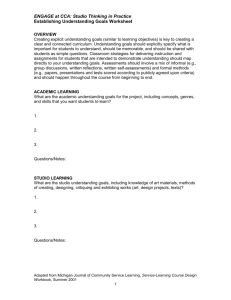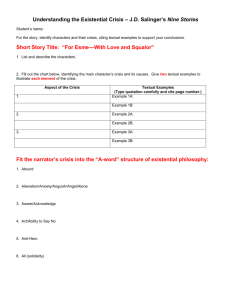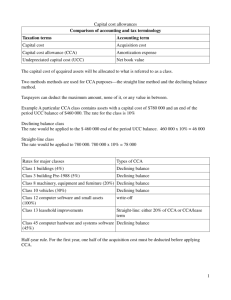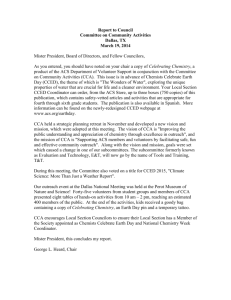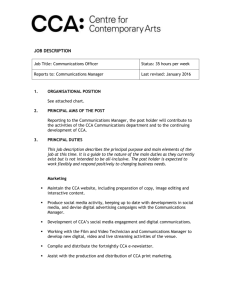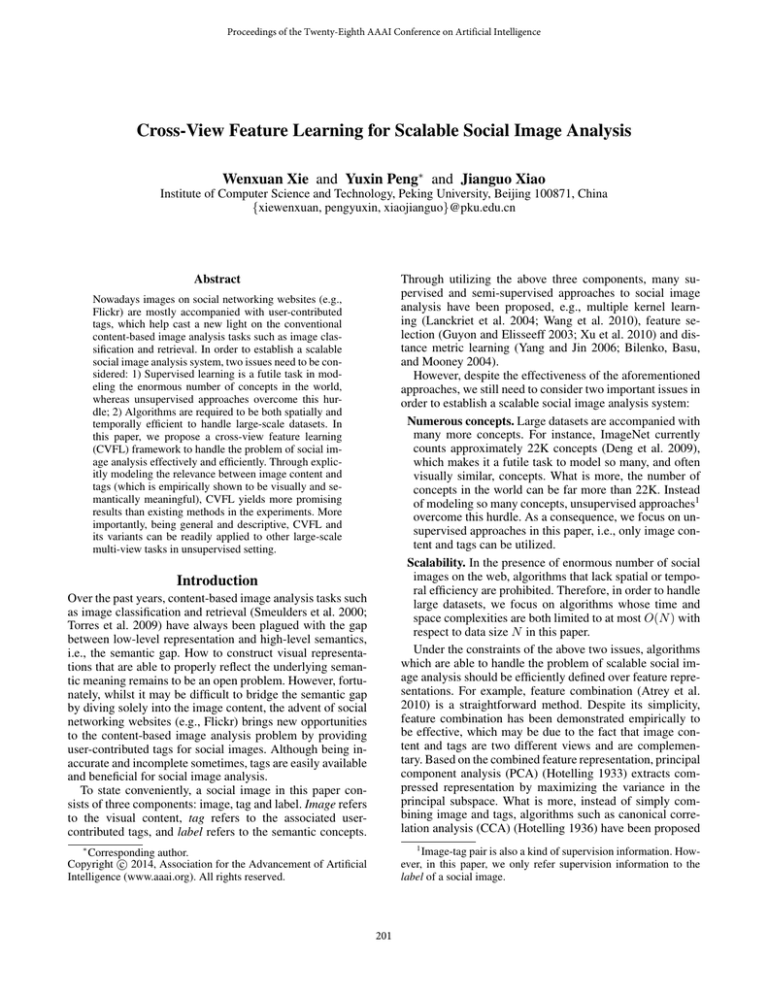
Proceedings of the Twenty-Eighth AAAI Conference on Artificial Intelligence
Cross-View Feature Learning for Scalable Social Image Analysis
Wenxuan Xie and Yuxin Peng∗ and Jianguo Xiao
Institute of Computer Science and Technology, Peking University, Beijing 100871, China
{xiewenxuan, pengyuxin, xiaojianguo}@pku.edu.cn
Abstract
Through utilizing the above three components, many supervised and semi-supervised approaches to social image
analysis have been proposed, e.g., multiple kernel learning (Lanckriet et al. 2004; Wang et al. 2010), feature selection (Guyon and Elisseeff 2003; Xu et al. 2010) and distance metric learning (Yang and Jin 2006; Bilenko, Basu,
and Mooney 2004).
However, despite the effectiveness of the aforementioned
approaches, we still need to consider two important issues in
order to establish a scalable social image analysis system:
Numerous concepts. Large datasets are accompanied with
many more concepts. For instance, ImageNet currently
counts approximately 22K concepts (Deng et al. 2009),
which makes it a futile task to model so many, and often
visually similar, concepts. What is more, the number of
concepts in the world can be far more than 22K. Instead
of modeling so many concepts, unsupervised approaches1
overcome this hurdle. As a consequence, we focus on unsupervised approaches in this paper, i.e., only image content and tags can be utilized.
Scalability. In the presence of enormous number of social
images on the web, algorithms that lack spatial or temporal efficiency are prohibited. Therefore, in order to handle
large datasets, we focus on algorithms whose time and
space complexities are both limited to at most O(N ) with
respect to data size N in this paper.
Under the constraints of the above two issues, algorithms
which are able to handle the problem of scalable social image analysis should be efficiently defined over feature representations. For example, feature combination (Atrey et al.
2010) is a straightforward method. Despite its simplicity,
feature combination has been demonstrated empirically to
be effective, which may be due to the fact that image content and tags are two different views and are complementary. Based on the combined feature representation, principal
component analysis (PCA) (Hotelling 1933) extracts compressed representation by maximizing the variance in the
principal subspace. What is more, instead of simply combining image and tags, algorithms such as canonical correlation analysis (CCA) (Hotelling 1936) have been proposed
Nowadays images on social networking websites (e.g.,
Flickr) are mostly accompanied with user-contributed
tags, which help cast a new light on the conventional
content-based image analysis tasks such as image classification and retrieval. In order to establish a scalable
social image analysis system, two issues need to be considered: 1) Supervised learning is a futile task in modeling the enormous number of concepts in the world,
whereas unsupervised approaches overcome this hurdle; 2) Algorithms are required to be both spatially and
temporally efficient to handle large-scale datasets. In
this paper, we propose a cross-view feature learning
(CVFL) framework to handle the problem of social image analysis effectively and efficiently. Through explicitly modeling the relevance between image content and
tags (which is empirically shown to be visually and semantically meaningful), CVFL yields more promising
results than existing methods in the experiments. More
importantly, being general and descriptive, CVFL and
its variants can be readily applied to other large-scale
multi-view tasks in unsupervised setting.
Introduction
Over the past years, content-based image analysis tasks such
as image classification and retrieval (Smeulders et al. 2000;
Torres et al. 2009) have always been plagued with the gap
between low-level representation and high-level semantics,
i.e., the semantic gap. How to construct visual representations that are able to properly reflect the underlying semantic meaning remains to be an open problem. However, fortunately, whilst it may be difficult to bridge the semantic gap
by diving solely into the image content, the advent of social
networking websites (e.g., Flickr) brings new opportunities
to the content-based image analysis problem by providing
user-contributed tags for social images. Although being inaccurate and incomplete sometimes, tags are easily available
and beneficial for social image analysis.
To state conveniently, a social image in this paper consists of three components: image, tag and label. Image refers
to the visual content, tag refers to the associated usercontributed tags, and label refers to the semantic concepts.
1
∗
Image-tag pair is also a kind of supervision information. However, in this paper, we only refer supervision information to the
label of a social image.
Corresponding author.
c 2014, Association for the Advancement of Artificial
Copyright Intelligence (www.aaai.org). All rights reserved.
201
Feature Selection
to model the relevance between these two views. CCA maximizes the correlation between visual and textual representations by learning two linear mappings. Similar to CCA,
partial least squares regression (PLSR) (Wold 1985) pursues
the direction which maximizes the covariance between these
two views.
However, despite the advantages, CCA involves a generalized eigenvalue problem, which is computationally expensive to solve. Furthermore, it is challenging to derive variants of CCA, e.g., sparse CCA. As sparse CCA involves a
difficult sparse generalized eigenvalue problem, convex relaxation of sparse CCA has been studied in (Sriperumbudur,
Torres, and Lanckriet 2007), where the exact formulation
has been relaxed in several steps. Therefore, although CCA
can be regularized to prevent the overfitting and avoid the
singularity (Bach and Jordan 2003), it is generally difficult
for CCA to be compatible with many other kinds of regularizers, e.g., sparsity and group sparsity.
In this paper, we propose a cross-view feature learning
(CVFL) framework to explicitly model the relevance between image and tags by learning a linear mapping from
textual representation to visual representation. In contrast to
CCA, the relevance learned by CVFL is shown to be visually and semantically meaningful. More notably, CVFL is a
general framework and can be readily applied to other largescale multi-view tasks by imposing other kinds of regularizers. Moreover, besides its adaptability, CVFL is shown to be
more effective and efficient empirically.
The rest of this paper is organized as follows. Section
2 presents a brief overview of related studies. The CVFL
framework is introduced in Section 3. Section 4 justifies
CVFL by showing its technical soundness. In order to dive
deeper into the problem, more details on the relation between CVFL and CCA are shown in Section 5. In Section
6, the performance of our proposed method is evaluated on
two real-world datasets in image classification. Finally, Section 7 concludes our paper.
Feature selection is aiming at selecting a subset of features
satisfying some predefined criteria, which is essentially a
computationally expensive combinatorial optimizing problem which is NP-hard (Amaldi and Kann 1998). The criteria of most feature selection algorithms are related to labels (Guyon and Elisseeff 2003; Xu et al. 2010). Besides,
in cases where no labels are provided, unsupervised feature
selection (Xing and Karp 2001; Cai, Zhang, and He 2010)
is applicable by using criteria such as saliency, entropy, etc.
However, as stated above, feature selection involves a combinatorial optimizing problem which is time-consuming to
solve. As an example, (Cai, Zhang, and He 2010) requires a
time complexity of O(N 2 ) with respect to data size N , and
thus may face challenges in dealing with large-scale tasks.
What is more, feature selection does not take into account
the relevance between multiple views.
Distance Metric Learning
Most distance metric learning (DML) algorithms (Yang
and Jin 2006; Bilenko, Basu, and Mooney 2004) learn a
Mahalanobis distance matrix. Due to the positive semidefiniteness of the matrix, the learned result can be derived
as a linear mapping of the original feature, which is similar
to the proposed CVFL at this point. However, most DML
methods require triplets (x, x+ , x− ) as inputs, which indicate that image x and x+ are similar/relevant, while image x
and x− are dissimilar/irrelevant. In a social image analysis
system, similar pairs can be easily obtained (i.e., image-tag
pairs), but dissimilar pairs are generally not directly available due to the fact that the dissimilar information is often
related to labels (Wu et al. 2013) or user feedback (Xia, Wu,
and Hoi 2013). Besides, (Li et al. 2012) only utilizes imagetag pairs to derive a distance metric; however, the spatial and
temporal complexities are both O(N 2 ).
Latent Semantic Learning
Many algorithms have been proposed to model the correspondence of different views in automatic image annotation.
Probabilistic graphical models (Putthividhy, Attias, and Nagarajan 2010; Jia, Salzmann, and Darrell 2011) aim to describe the correlations between images and tags by learning a correspondence between visual representation and textual representation in order to predict annotations of a new
test image. Different from the aim of the above methods
(which is to predict tags given a new image), the objective
of CVFL is to derive a descriptive representation for social
image analysis given both image and tags. More notably,
CVFL deals with a convex optimization problem and the solution does not rely on a time-consuming iterative optimization procedure.
Related Work
In this section, we present a brief overview of related studies
and discuss their similarities and differences with the proposed CVFL. These studies include multiple kernel learning,
feature selection, distance metric learning and latent semantic learning.
Multiple Kernel Learning
Given multiple kernels for feature combination, it is nontrivial to determine weights of each kernel. To tackle this
issue, supervised multiple kernel learning (MKL) (Lanckriet et al. 2004) algorithms have been proposed to determine
these weights based on the max-margin criterion, and have
achieved state-of-the-art performance on some image recognition applications (Vedaldi et al. 2009). Moreover, semisupervised MKL (Wang et al. 2010) has also been proposed
to utilize unlabeled data. However, since these approaches
require labels, it may be challenging to apply these approaches to problems with huge numbers of concepts.
The CVFL Framework
In this section, we introduce the CVFL framework by giving
some preliminaries first. After that, we present the formulation and solution to CVFL, respectively. Finally, the complexity issue is discussed.
202
Preliminaries
N ×M1
store in large-scale datasets. In contrast, CVFL models the
affinity of visual features, which is irrelevant to the data size
N . As a consequence, by imposing the above Laplacian regularizer onto Eq. 2, we obtain the following objective function, which is the formulation of CVFL.
N ×M2
Unless otherwise specified, X ∈ R
and V ∈ R
denote feature representations in two heterogeneous views,
respectively (e.g., image and tag representation in this paper). U ∈ RM2 ×M1 denotes a linear mapping. In this case,
the number of samples is N , and the feature dimensionalities in the two views are M1 and M2 . Moreover, Xi. , X.j
and Xij respectively denote the i-th row vector, j-th column
vector and (i, j)-th element of the matrix X. In other words,
Xi. is the i-th sample, and X.j represents the j-th feature.
min kX̂ − Xk2F + λkU k2F + γ tr(U LU > )
(5)
where γ is also a regularization parameter.
Solution
Formulation
The formulation of CVFL shown in Eq. 5 is a constrained
optimization problem. By substituting the constraint X̂ =
V U into Eq. 5, we may arrive at the following unconstrained
optimization function
In order to effectively handle social image analysis, it is important to derive a descriptive feature representation. In this
paper, we propose to embed the textual semantics into the
visual representation through explicitly modeling the relevance between image and tags. To ensure its descriptive
power, the learned representation (denoted as X̂) should encode the information from both X and V . With these considerations in mind, we have the following equation.
min kX̂ − Xk2F
s. t. X̂ = V U
min kV U − Xk2F + λkU k2F + γ tr(U LU > )
U
(1)
(V > V + λIM2 )U + γU L − V > X = 0
min kX̂ −
X̂,U
+
s. t. X̂ = V U
S1 U + U S2 + S3 = 0
(8)
>
>
where S1 = V V + λIM2 , S2 = γL, and S3 = −V X
here. Eq. 8 can be rewritten as follows
(IM1 ⊗ S1 + S2> ⊗ IM2 ) · vec(U ) = − vec(S3 )
(2)
(9)
where ⊗ is the Kronecker product defined as U ⊗ V =
[Uij · V ] for any two matrices U and V , and vec(S3 ) is the
unfolded vector of matrix S3 . Then, Eq. 9 can be solved by
a linear equation shown as follows.
where λ is a regularization parameter. Furthermore, based
on the fact that visual features (i.e., X.j ) are linearly reconstructed by textual features, we may derive a constraint on
the reconstruction weights by modeling the affinity of visual
features. As long as we constrain the difference between the
reconstruction weights of similar visual features to be small,
we may arrive at the following Laplacian regularizer (Belkin
and Niyogi 2001).
X
kU.i − U.j k22 Aij = tr(U LU > )
(3)
vec(U ) = −(IM1 ⊗ S1 + S2> ⊗ IM2 )−1 · vec(S3 )
(10)
N ×M1
After obtaining U , we can derive X̂ ∈ R
by computing X̂ = V U as the final representation for the social
image analysis task.
Computational Complexity
Solving Eq. 8 requires O(max(M1 , M2 )3 ). Moreover, computing V > V and V > X in Eq. 7 may both incur a time complexity of O(N M1 M2 ), and the complexity of constructing
a Laplacian L is O(N M12 ). In summary, the total complexity
is O(N M1 M2 + N M12 + max(M1 , M2 )3 ), which is linear
with respect to the data size N . Therefore, CVFL can perform efficiently as the data size increases. Notably, however,
feature dimensionalities (i.e., M1 and M2 ) generally remain
to be moderate and stable in practice.
i,j
where Aij denotes the affinity of the i-th and j-th visual
features, and L ∈ RM1 ×M1 is a Laplacian matrix. The normalized Laplacian is defined as L = I − G−1/2 AG−1/2 ,
where G is a diagonal matrix with its (i, i)-th element equal
to the sum of the i-th column vector of A. For conciseness,
we obtain the pairwise affinity graph A by computing the inner products of all observations shown as follows, although
there are a few studies on constructing better graphs (Yan
and Wang 2009; Lu and Peng 2013).
A = X >X
(7)
where IM2 stands for an M2 × M2 identity matrix. Eq. 7
is exactly the form of a Lyapunov-like equation in control
theory, i.e., the Sylvester equation, whose standard form is
As shown in Eq. 1, by constraining the resultant representation X̂ to be close to X and to be a linear mapping of V , X̂
obtains information conveyed by both X and V (which will
be justified later in Section 4). Being a reconstruction formulation, Eq. 1 is compatible with many regularizers such
as graph Laplacian and sparsity. As a first step, we pose an
L2 regularizer to avoid overfitting and ensure numerical stability.
λkU k2F
(6)
which is a convex optimization problem. By computing the
derivative of Eq. 6 with respect to U and set it to 0, we can
obtain the following equation after some algebra
X̂,U
Xk2F
s. t. X̂ = V U
X̂,U
Justification of CVFL
(4)
The underlying rationale of CVFL is presented in this section. We begin by justifying the effectiveness, and then illustrate the learned relevance between image content and tags
with a toy example.
It should be noted that, many graph-based approaches
model the affinity of samples (Li et al. 2012), and thus involves an N × N graph which is difficult to compute and
203
Justification
Sample patches of a visual feature
Since Eq. 5 is a regularized form of Eq. 1, for simplicity,
we demonstrate that the learned representation X̂ encodes
the information from both X and V according to Eq. 1. To
begin with, since the squared error between X̂ and X is minimized, X̂ is constrained to be close to X and thus obtains
the information conveyed by X. However, it is nontrivial to
demonstrate the relation between X̂ and V .
Inspired by locality-sensitive hashing (Gionis, Indyk, and
Motwani 1999) which constructs randomized hash functions
by using random projections, we can establish distancepreserving mappings through using random projections.
Random projection is based on the Johnson-Lindenstrauss
lemma (Johnson and Lindenstrauss 1984) and can be extended to the following theorem (Vempala 2004), where inner products are preserved under random projection.
Theorem 1 Let p, q ∈ RM2 and that kpk ≤ 1 and kqk ≤ 1.
1
Let f (x) = √M
U x where U is an M1 × M2 matrix, where
1
each entry is sampled i.i.d from a Gaussian N (0, 1). Then,
2
3
Pr(|p · q − f (p) · f (q)| ≥ ) ≤ 4e−( − )k/4 .
where Pr(·) denotes a probability. Besides sampling i.i.d
from a normalized Gaussian, sparse random projections
(Achlioptas 2001) are also applicable. What is more, the authors in (Bingham and Mannila 2001) have stated that:
In random projection, the original d-dimensional data
is projected to a k-dimensional (k d) subspace base
through the origin, using a random k × d matrix whose
columns have unit lengths.
Based on the above statement, we now demonstrate that the
columns of the linear mapping matrix U have unit lengths.
Given that all the features in X and V have been normalized to zero mean and unit variance, column vectors X.i and
V.j can be viewed as normalized Gaussian N (0, 1). Furthermore, being constrained to be close to X.i , X̂.i can also be
viewed as a normalized Gaussian. Therefore, we have
clouds bay
runway bowing
city mountain
flag helicopter
branch leaf
Figure 1: A toy example of some visual features and their top
two relevant textual features. Visual features are represented
by their corresponding unquantized image patches.
It can be observed that the inner products are preserved
with a high probability, and thus we may conclude that X̂
encodes the information conveyed by V .
Illustration of the Learned Relevance
CVFL explicitly models the relevance between image and
tags by learning a linear mapping from textual representation to visual representation. To better illustrate the learned
relevance, we interpret the model from the perspective of
weighted summation. Based on Eq. 1, we have
min kV U − Xk2F
U
j=1
It means that the i-th visual feature equals to a weighted
sum of all the M2 textual features. The higher the weight
Uji (which can be interpreted as a relative importance), the
more relevant the visual feature X.i and the textual feature
V.j are. It should be noted that, a visual feature is a cluster center derived by image patches (and thus can be represented by these patches), and a textual feature is a word.
To illustrate the learned relevance, we pick out the textual
features which are most relevant to a given visual feature by
sorting Uji in descending order, where j ∈ {1, . . . , M2 }.
Fig. 1 illustrates a toy example of some visual features (i.e.,
image patches) and their corresponding top two relevant textual features (i.e., words), which is derived from a subset of
the Corel-5K dataset (Duygulu et al. 2002). It can observed
that the learned relevance between visual features and textual features is both visually and semantically meaningful.
and
M2
X
j=1
=⇒V U.i ∼
M2
X
Uji · V.j =⇒ V U.i ∼
M2
X
Uji · N (0, 1)
j=1
2
N (0, Uji
) =⇒ V U.i ∼ N (0,
j=1
M2
X
(11)
Since the squared Frobenius norm is always nonnegative,
the minimum of Eq. 11 is 0 if X = V U holds. Hence, we
may arrive at
M2
X
V.j Uji
(12)
X.i =
X̂ = V U =⇒ X̂.i = V U.i
V U.i =
Top two words
2
Uji
)
j=1
PM2
2
j=1 Uji
Since X̂.i ∼ N (0, 1), the equation
= 1 holds,
which demonstrates that the columns of the linear mapping
matrix U have unit lengths, and that the conditions in Theorem 1 are satisfied.
If we let p and q be the i-th and j-th textual samples (i.e.,
Vi. and Vj. ) respectively, f (p) and f (q) respectively denote
X̂i. and X̂j. . k is the dimensionality of visual representation
(say 1,000 in practice) and is a parameter (say 0.1 in the
current case). As a consequence, the following inequality
holds according to Theorem 1.
Relation to CCA
In this section, we discuss the relation between CCA and
the proposed CVFL, both of which model the relevance between two views. CCA maximizes the correlation coefficient, whereas CVFL learns a linear mapping from one view
Pr(|Vi. · Vj. − X̂i. · X̂j. | ≥ 0.1) ≤ 0.105
204
Experimental Setup
to another. In (Sun, Ji, and Ye 2011), the authors demonstrate that CCA in the multi-label classification case (where
one of the views used in CCA is derived from the labels)
can be formulated as a least squares problem under some
conditions. Take Eq. 11 (unregularized form of CVFL) as an
example, if rank(X) = M1 and rank(V ) = N − 1, CCA
and least squares regression are equivalent, i.e., the learned
linear mappings of both the two approaches are the same.
However, with the growing number of images, the data
size N is generally larger than feature dimensionalities M1
and M2 in practice. Hence, the condition rank(V ) = N − 1
does not hold, and CVFL is different from CCA. Fortunately, despite the difference, the technical soundness of
CVFL can be justified by resorting to the theory of random
projection (as shown in the previous section).
The advantage of CVFL is twofold. On one hand, CCA
involves a time-consuming generalized eigenvalue problem
(Watkins 2004), whereas it is more efficient to solve a least
squares problem such as CVFL. On the other hand, it is
challenging to derive the formulation if regularizers (such as
smoothness2 , sparsity and group sparsity) are added to CCA.
In contrast, CVFL is generally compatible with all such regularizers, and thus can be made more descriptive by applying
different regularizers.
Furthermore, we show how CVFL can be extended to deal
with more than two views. To begin with, we relax the constraints in Eq. 5 to be
min kX̂ − Xk2F + R(U ) + µkX̂ − V U k2F
We conduct experiments on two publicly-available datasets
in the multi-class classification setting. The first dataset is
Corel-5K (Corel for short) (Duygulu et al. 2002), which is
composed of 50 categories and each containing 100 images
collected from the larger COREL CD set. Following the partition of the dataset, 4,500 images are used for training and
the rest are used for test. Tags in the dataset are from a dictionary of 374 keywords, with each image having been annotated by an average of 3.5 tags.
The second dataset is NUS-WIDE-Object (NUS for short)
(Chua et al. 2009), which is collected from the photo sharing website Flickr. In order to fit for the multi-class classification setting, we only select the images with a single
class label, and thus obtain 23,953 images from all 31 categories. Note that the same strategy has already been adopted
in (Gao, Chia, and Tsang 2011), where the authors have selected images with a single class label from 26 classes. We
follow the standard train/test partition of the dataset, where
the training set and the test set contain 14,270 and 9,683 images, respectively. Moreover, the most frequent 1,000 tags
are retained on this dataset, with each image having been
annotated by an average of 6.6 tags.
To generate the visual representation for the Corel dataset,
we extract the SIFT descriptors (Lowe 2004) of 16×16 pixel
blocks computed over a regular grid with spacing of 8 pixels. We then perform k-means clustering on the extracted descriptors to form a vocabulary of 2,000 visual words. Based
on the visual vocabulary, a 2,000-dimensional feature vector
is obtained for each image. For the NUS dataset, we adopt
the 500-dimensional bag-of-words representation available
online for all the images. What is more, a binary matrix
recording tag presence/absence is used as the textual representation for both datasets.
As the final step, we adopt linear SVM (Fan et al. 2008)
to obtain the classification accuracy for evaluation.
(13)
X̂,U
where R(U ) denotes the regularizers on U (which can also
be substituted to sparsity constraints, etc). In cases where
there are more than two views (say X, V1 and V2 ), Eq. 13
can be extended to the following form
min kX̂ − Xk2F + R(U1 ) + µ1 kX̂ − V1 U1 k2F
X̂,U1 ,U2
(14)
+R(U2 ) + µ2 kX̂ − V2 U2 k2F
Empirical Results
To demonstrate the effectiveness of the proposed CVFL, we
evaluate the performance of the following methods/features:
Consequently, the learned representation X̂ encodes the
information conveyed by X, V1 and V2 .
• Visual Representation Only.
Experiments
• Textual Representation Only.
In this section, we evaluate the performance of the proposed CVFL in social image analysis. We begin by describing the experimental setup. As a next step, empirical
results of CVFL and other related methods are reported.
Finally, we present the parameter tuning details and discuss the complexity issues. It should be noted that, CVFL
can be readily applied to other multi-view tasks in unsupervised setting (e.g., social image retrieval without labeled
relevant/irrelevant examples), although the evaluation metric
adopted in this paper is classification accuracy.
• Textual Representation (Random Projection), which
denotes the result derived from text representation with
a random projection.
2
This paper efficiently models the smoothness of visual features (as shown in Eq. 3), which is different from studies on semisupervised CCA (Blaschko, Lampert, and Gretton 2008), whose
time complexity is at least O(N 2 ).
• CCA, which denotes the canonical correlation analysis
(Hotelling 1936). CCA is performed to maximize the correlation between visual representation and textual representation, and the learned representations are combined.
• Visual + Textual Representation, which denotes the
combination of visual representation and textual representation.
• PCA, which denotes the principal component analysis
(Hotelling 1933) approach. PCA is performed on the combined representation of image and tags.
205
80
78
78
76
76
Classification Accuracy (%)
NUS
31.0
68.6
71.6
69.5
69.5
69.2
66.8
62.5
74.7
80
74
72
70
68
66
64
62
60
74
72
70
68
66
64
62
0
0.5
1
γ
1.5
60
2
0
(a) Corel, λ=1.5
• PLSR, which denotes the partial least squares regression (Wold 1985) approach. PLSR is performed similarly
with CCA, except that PLSR maximizes covariance while
CCA maximizes correlation.
80
80
78
78
76
76
74
72
70
68
66
64
62
60
1
λ
1.5
2
74
72
70
68
66
64
62
0
0.5
1
γ
1.5
(c) NUS, λ=1.7
• CVFL (without regularizer), which denotes the proposed cross-view feature learning approach without any
regularizers (Eq. 1).
0.5
(b) Corel, γ=1.8
Classification Accuracy (%)
Corel
46.2
68.6
68.4
70.6
70.6
70.4
68.2
66.8
71.8
Classification Accuracy (%)
Methods/Features
Visual Representation Only
Textual Representation Only
Textual Representation (Random Projection)
Visual + Textual Representation
Principal Component Analysis (PCA)
Canonical Correlation Analysis (CCA)
Partial Least Squares Regression (PLSR)
CVFL (proposed, without regularizer)
CVFL (proposed)
Classification Accuracy (%)
Table 1: Classification accuracy (%) of the proposed CVFL
along with other methods/features on Corel dataset and NUS
dataset.
2
60
0
0.5
1
λ
1.5
2
(d) NUS, γ=1.9
Figure 2: The 5-fold cross-validation results of λ and γ on:
(a,b) Corel; (c,d) NUS.
• CVFL, which denotes the proposed cross-view feature
learning approach (Eq. 5). The learned representation X̂
is used to evaluate the final performance.
Table 2: Running time (measured in seconds) of CCA and
the proposed CVFL on Corel dataset and NUS dataset.
Methods
Corel NUS
CCA
28.7
47.1
CVFL (proposed) 17.1
11.0
The classification results of all the aforementioned methods/features are listed in Table 1. Several observations can
be made concerning the results. To begin with, CVFL performs better than a single representation, since the representation X̂ learned by CVFL encodes the information from
both image and tags. Secondly, CVFL turns out to be more
effective than a random mapping on textual representation,
which shows that the mapping learned by CVFL is more descriptive than a randomly generated one, although CVFL is
inspired by the idea of random projection. What is more,
due to the explicit modeling of the relevance between image and tags, CVFL outperforms feature combination. Because the mapping learned by PCA is an orthogonal matrix, the results obtained by PCA and feature combination
are the same. More importantly, being a reconstruction formulation, CVFL is compatible with many kinds of regularizers. With these regularizers, CVFL becomes more descriptive and obtains better results than CCA and PLSR. Finally,
it can be learned from the underperformance of the unregularized CVFL that, regularizers are important for CVFL, and
the result of overfitting can be catastrophic.
(measured in seconds) of the following two closely-related
approaches: CCA and CVFL. Note that we run MATLAB
codes on a server with 2.20GHz CPU and 128GB RAM. It
can be observed from Table 2 that, CVFL performs more efficiently than CCA. The above results may be due to the fact
that CCA involves a generalized eigenvalue problem which
is computationally more expensive to solve, whereas it is
more efficient to solve a least squares problem like CVFL.
More notably, although the NUS dataset contains more images, CVFL remains to be efficient.
Conclusion and Future Work
Due to numerous concepts in the real world and the scalability issues, a suitable approach to practical social image
analysis is constrained to be unsupervised and computationally efficient. In this paper, we propose a cross-view feature learning (CVFL) framework to handle this task. As the
promising results shown in the experiments, the proposed
CVFL is an effective algorithm, although some simple settings are adopted in this paper (e.g., using a simple L2 regularizer instead of a sparsity or group sparsity regularizer, and
using inner products to model the affinity of visual features).
Taking into account that CVFL can be made more descriptive by using other types of regularizers, and that CVFL is
only defined over feature representations, we will conduct a
deeper analysis on the effectiveness of CVFL by investigating different regularizers, and apply CVFL to other largescale multi-view tasks in unsupervised setting.
Parameters and Complexity Issues
Parameters are determined by 5-fold cross-validation in the
experiments. We empirically find that the performance of
CVFL reaches its peak when both λ and γ are chosen between 1 and 2. Concretely, we choose λ = 1.5 and γ = 1.8
for the Corel dataset, and choose λ = 1.7 and γ = 1.9 for
the NUS dataset. The detailed cross-validation results are illustrated in Fig. 2. It is noteworthy that CVFL is not sensitive
to these parameters.
Besides parameter tuning, to systematically investigate
the complexity issues, we report in Table 2 the running time
206
Acknowledgments
Jia, Y.; Salzmann, M.; and Darrell, T. 2011. Learning crossmodality similarity for multinomial data. In ICCV, 2407–2414.
Johnson, W., and Lindenstrauss, J. 1984. Extensions of Lipschitz
mappings into a Hilbert space. In Conference in Modern Analysis
and Probability, volume 26, 189–206.
Lanckriet, G.; Cristianini, N.; Bartlett, P.; Ghaoui, L.; and Jordan,
M. 2004. Learning the kernel matrix with semidefinite programming. JMLR 5:27–72.
Li, Z.; Liu, J.; Jiang, Y.; Tang, J.; and Lu, H. 2012. Low rank metric
learning for social image retrieval. In ACM MM, 853–856.
Lowe, D. 2004. Distinctive image features from scale-invariant
keypoints. IJCV 60(2):91–110.
Lu, Z., and Peng, Y. 2013. Latent semantic learning with structured sparse representation for human action recognition. PR
46(7):1799–1809.
Putthividhy, D.; Attias, H.; and Nagarajan, S. 2010. Topic regression multi-modal latent dirichlet allocation for image annotation.
In CVPR, 3408–3415.
Smeulders, A. W.; Worring, M.; Santini, S.; Gupta, A.; and Jain, R.
2000. Content-based image retrieval at the end of the early years.
TPAMI 22(12):1349–1380.
Sriperumbudur, B. K.; Torres, D. A.; and Lanckriet, G. R. 2007.
Sparse eigen methods by dc programming. In ICML, 831–838.
Sun, L.; Ji, S.; and Ye, J. 2011. Canonical correlation analysis for
multilabel classification: A least-squares formulation, extensions,
and analysis. TPAMI 33(1):194–200.
Torres, R. d. S.; Falcão, A. X.; Gonçalves, M. A.; Papa, J. P.; Zhang,
B.; Fan, W.; and Fox, E. A. 2009. A genetic programming framework for content-based image retrieval. PR 42(2):283–292.
Vedaldi, A.; Gulshan, V.; Varma, M.; and Zisserman, A. 2009.
Multiple kernels for object detection. In ICCV, 606–613.
Vempala, S. S. 2004. The random projection method. AMS Bookstore.
Wang, S.; Jiang, S.; Huang, Q.; and Tian, Q. 2010. S3mkl: scalable
semi-supervised multiple kernel learning for image data mining. In
ACM MM, 163–172.
Watkins, D. S. 2004. Fundamentals of matrix computations. John
Wiley & Sons.
Wold, H. 1985. Partial least squares. Encyclopedia of statistical
sciences.
Wu, P.; Hoi, S. C.; Xia, H.; Zhao, P.; Wang, D.; and Miao, C. 2013.
Online multimodal deep similarity learning with application to image retrieval. In ACM MM, 153–162.
Xia, H.; Wu, P.; and Hoi, S. C. 2013. Online multi-modal distance
learning for scalable multimedia retrieval. In ACM WSDM, 455–
464.
Xing, E. P., and Karp, R. M. 2001. Cliff: clustering of highdimensional microarray data via iterative feature filtering using
normalized cuts. Bioinformatics 17(suppl 1):S306–S315.
Xu, Z.; King, I.; Lyu, M.-T.; and Jin, R. 2010. Discriminative
semi-supervised feature selection via manifold regularization. TNN
21(7):1033–1047.
Yan, S., and Wang, H. 2009. Semi-supervised learning by sparse
representation. In SDM, 792–801.
Yang, L., and Jin, R. 2006. Distance metric learning: A comprehensive survey. Michigan State Universiy 1–51.
This work was supported by National Hi-Tech Research and
Development Program (863 Program) of China under Grants
2014AA015102 and 2012AA012503, National Natural Science Foundation of China under Grant 61371128, and Ph.D.
Programs Foundation of Ministry of Education of China under Grant 20120001110097.
References
Achlioptas, D. 2001. Database-friendly random projections. In
PODS, 274–281.
Amaldi, E., and Kann, V. 1998. On the approximability of minimizing nonzero variables or unsatisfied relations in linear systems.
Theoretical Computer Science 209(1):237–260.
Atrey, P. K.; Hossain, M. A.; El Saddik, A.; and Kankanhalli, M. S.
2010. Multimodal fusion for multimedia analysis: a survey. Multimedia Systems 16(6):345–379.
Bach, F. R., and Jordan, M. I. 2003. Kernel independent component
analysis. JMLR 3:1–48.
Belkin, M., and Niyogi, P. 2001. Laplacian eigenmaps and spectral
techniques for embedding and clustering. NIPS 14:585–591.
Bilenko, M.; Basu, S.; and Mooney, R. J. 2004. Integrating
constraints and metric learning in semi-supervised clustering. In
ICML, 11.
Bingham, E., and Mannila, H. 2001. Random projection in dimensionality reduction: applications to image and text data. In ACM
KDD, 245–250.
Blaschko, M. B.; Lampert, C. H.; and Gretton, A. 2008. Semisupervised laplacian regularization of kernel canonical correlation
analysis. In ECML PKDD. 133–145.
Cai, D.; Zhang, C.; and He, X. 2010. Unsupervised feature selection for multi-cluster data. In ACM KDD, 333–342.
Chua, T.-S.; Tang, J.; Hong, R.; Li, H.; Luo, Z.; and Zheng, Y.
2009. Nus-wide: a real-world web image database from national
university of singapore. In ACM CIVR, 48.
Deng, J.; Dong, W.; Socher, R.; Li, L.-J.; Li, K.; and Fei-Fei, L.
2009. Imagenet: A large-scale hierarchical image database. In
CVPR, 248–255.
Duygulu, P.; Barnard, K.; Freitas, J. F. G. d.; and Forsyth, D. A.
2002. Object recognition as machine translation: Learning a lexicon for a fixed image vocabulary. ECCV 97–112.
Fan, R.; Chang, K.; Hsieh, C.; Wang, X.; and Lin, C. 2008. Liblinear: A library for large linear classification. JMLR 9:1871–1874.
Gao, S.; Chia, L.; and Tsang, I. 2011. Multi-layer group sparse
coding–For concurrent image classification and annotation. In
CVPR, 2809–2816.
Gionis, A.; Indyk, P.; and Motwani, R. 1999. Similarity search in
high dimensions via hashing. In VLDB, 518–529.
Guyon, I., and Elisseeff, A. 2003. An introduction to variable and
feature selection. JMLR 3:1157–1182.
Hotelling, H. 1933. Analysis of a complex of statistical variables
into principal components. Journal of Educational Psychology
24(6):417–441.
Hotelling, H. 1936. Relations between two sets of variates.
Biometrika 28(3/4):321–377.
207


